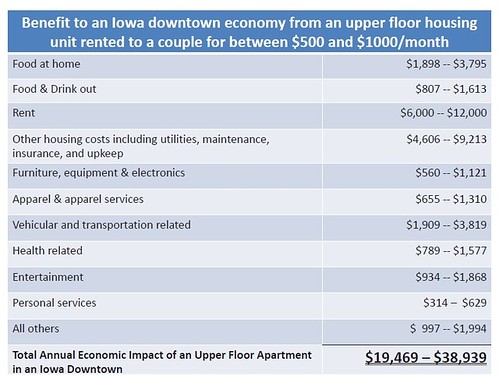Burying the lead: economic value of each new household added to a commercial district-neighborhood-city
The previous entry discussing historic preservation called out one of the slides from the presentation to Main Street Iowa about the economic impact of adding housing to "downtown" commercial districts. Typically this is space that is converted to residential, located above ground floor retail, or conversion of office buildings, etc.
-- Upper Story Housing Case Studies: Creative Solutions and Lessons Learned, Main Street Iowa
-- Upstairs Downtown program, Illinois Historic Preservation Agency
-- "Downtown is looking up!," Middletown Eye
-- TIF Upper Story Housing Program, Rock Island, Illinois
-- Philadelphia 10-Year Property Tax Abatement program on new and conversion residential projects, study by EcoConsult
-- Upper Story Redevelopment Strategies for Downtown Revitalization, City of Cumberland, Maryland
I made the point that this type of economic impact is important generally, regardless of if it's an "upper story" housing development. Just adding more households (with money) is a good thing.
And so this research finding is extendable to other settings involving the addition of new housing to neighborhoods and commercial districts, whether it is "upper story" housing in existing buildings or new apartments or condominiums.
Economic value of the addition of housing to neighborhoods and commercial districts

This is in fact what is happening with the population influx that DC is experiencing now. Although the new households in DC and other large cities likely have much higher income than the households studied in Iowa, which means that there is even greater economic impact.
New residents spend new money, money that wasn't being spent in the local economy before, and more residents spend more money than fewer residents and some of it (more if there are more places to spend it that are local) is spent locally.
New spending allows for the revitalization of neighborhood commercial districts, places like 11th Street NW in Columbia Heights or Barracks Row on 8th Street SE in Capitol Hill or Upshur Street and Georgia Avenue in the area served by the Petworth Metro Station (which has been stoked by the addition of multiunit housing to the area), or 14th Street between Thomas Circle and U Street (in response to the Whole Foods Supermarket and the addition of a goodly amount of multiunit housing), etc.
And it is just in the last couple of years where these changes have become truly visible, having reached a kind of "critical mass" or "tipping point," coincident with escalation in the number of people moving into the city (about 1,000 people per month over the last two years).
Labels: commercial district revitalization, housing market, multi-unit housing, neighborhood revitalization, real estate development, urban design/placemaking




4 Comments:
I don't know Richard -- might be overstating the case.
You can see about half the "impact" is rent + car. Is that going to be "local spending?" I mean we can try to quantify it -- what percentage of my Archstone rent is local vs. national spending, but you'd go crazy trying to figure it out.
And as for the rest, ordering something on amazon isn't local at all.
And in terms of DC proper, it is the ability of the city to capture income tax streams and also the lack of cooking abiity of new residents (highest restaurant spend in the country still?) which is leveraging their arrival.
Goes back to something I said last week, in terms of assuming growth is good. The id of the voice machine speaking again? No question that growth can paper over a lot of flaws.
Not sure if you've seen this:
http://www.washingtonpost.com/business/capitalbusiness/golden-triangle-is-having-to-work-harder-for-retail-tenants/2013/02/01/869113b4-698c-11e2-95b3-272d604a10a3_story.html
Which also suggests there is growth in DC but also distribution within the city.
I didn't catch that article but I am not surprised. DC isn't that big in terms of population for one thing.
And office workers not living in the city have a very narrow slice of retail that they are "shopping" when they are working. E.g., convenience retail (CVS...) and quick service food.
So just because you have hundreds of thousands of workers here during the day doesn't mean that they will spend much other than on some meals, especially given that these days people have limited time for lunch (that is, no time to explore).
Plus a lot of office workers don't even know what's around and available. They just know what's between the Metro exit and their office entrance. (If they drive, they are even less familiar, since they park directly in their building.)
That being said, I've always thought that Connecticut Ave. and K Street is the potential 100% intersection for retail in DC--not unlike Union Square and then Market Street in San Francisco.
But to get to that point, the buildings would have to be significantly reconfigured at the lower levels.
This kind of concept is far beyond what the GTBID is capable of visioning, and would be damn hard to do in any case.
oh, and true about the car. I thought about that. We need a more specific center city study. E.g., less on a car, some on transportation.
And as always, you make good points about purchasing meals out of home having such a disproportionate impact. (I've come to think of "commercial" districts as more about eatertainment than anything else, especially retail.)
But yes, too, I've made points similar to the Archstone point you make for years. E.g., with hotels, most of the spend goes out of the city. That's also true for spend on retail, office, and housing that ultimately isn't locally owned.
Decades ago a professor I had did a kind of inputs-outputs analysis for Greater Ann Arbor. Those are tough studies to do.
This is a great post.
This post is about the Economic estimation of the expansion of lodging to neighborhoods and business regions.
Visit here-to buy medicine online from Online medicine store.
Post a Comment
<< Home